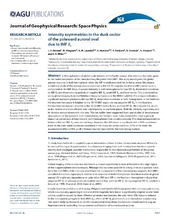| dc.contributor.author | Reistad, Jone Peter | eng |
| dc.contributor.author | Østgaard, Nikolai | eng |
| dc.contributor.author | Laundal, Karl Magnus | eng |
| dc.contributor.author | Haaland, Stein | eng |
| dc.contributor.author | Tenfjord, Paul | eng |
| dc.contributor.author | Snekvik, Kristian | eng |
| dc.contributor.author | Oksavik, Kjellmar | eng |
| dc.contributor.author | Milan, Steve | eng |
| dc.date.accessioned | 2015-09-03T11:35:49Z | |
| dc.date.available | 2015-09-03T11:35:49Z | |
| dc.date.issued | 2014-12 | |
| dc.identifier.issn | 2169-9402 | en_US |
| dc.identifier.issn | 2169-9380 | en_US |
| dc.identifier.uri | https://hdl.handle.net/1956/10386 | |
| dc.description.abstract | In the exploration of global-scale features of the Earth's aurora, little attention has been given to the radial component of the Interplanetary Magnetic Field (IMF). This study investigates the global auroral response in both hemispheres when the IMF is southward and lies in the xz plane. We present a statistical study of the average auroral response in the 12–24 magnetic local time (MLT) sector to an x component in the IMF. Maps of auroral intensity in both hemispheres for two IMF Bx dominated conditions (± IMF Bx) are shown during periods of negative IMF Bz, small IMF By, and local winter. This is obtained by using global imaging from the Wideband Imaging Camera on the IMAGE satellite. The analysis indicates a significant asymmetry between the two IMF Bx dominated conditions in both hemispheres. In the Northern Hemisphere the aurora is brighter in the 15–19 MLT region during negative IMF Bx. In the Southern Hemisphere the aurora is brighter in the 16–20 MLT sector during positive IMF Bx. We interpret the results in the context of a more efficient solar wind dynamo in one hemisphere. Both the intensity asymmetry and its location are consistent with this idea. This has earlier been suggested from case studies of simultaneous observations of the aurora in both hemispheres, but hitherto never been observed to have a general impact on global auroral brightness in both hemispheres from a statistical study. The observed asymmetries between the two IMF Bx cases are not large; however, the difference is significant with a 95% confidence level. As the solar wind conditions examined in the study are rather common (37% of the time) the accumulative effect of this small influence may be important for the total energy budget. | en_US |
| dc.language.iso | eng | eng |
| dc.publisher | American Geophysical Union | en_US |
| dc.publisher | Wiley | en_US |
| dc.relation.ispartof | <a href="http://hdl.handle.net/1956/12121" target="blank">Mechanisms responsible for asymmetric aurora between the conjugate hemispheres</a> | en_US |
| dc.rights | Attribution CC BY-NC-ND | eng |
| dc.rights.uri | http://creativecommons.org/licenses/by-nc-nd/4.0/ | eng |
| dc.title | Intensity asymmetries in the dusk sector of the poleward auroral oval due to IMF Bx | en_US |
| dc.type | Peer reviewed | |
| dc.type | Journal article | |
| dc.date.updated | 2015-06-29T09:15:20Z | |
| dc.description.version | publishedVersion | en_US |
| dc.rights.holder | Copyright 2014 The Authors | en_US |
| dc.identifier.doi | https://doi.org/10.1002/2014ja020216 | |
| dc.identifier.cristin | 1170351 | |
| dc.source.journal | Journal of Geophysical Research - Space Physics | |
| dc.source.40 | 119 | |
| dc.source.14 | 12 | |
| dc.source.pagenumber | 9497-9507 | |
| dc.relation.project | Norges forskningsråd: 223252 | |
| dc.relation.project | Norges forskningsråd: 212014 | |
| dc.subject.nsi | VDP::Matematikk og naturvitenskap: 400::Fysikk: 430 | |
| dc.subject.nsi | VDP::Mathematics and natural scienses: 400::Physics: 430 | |

